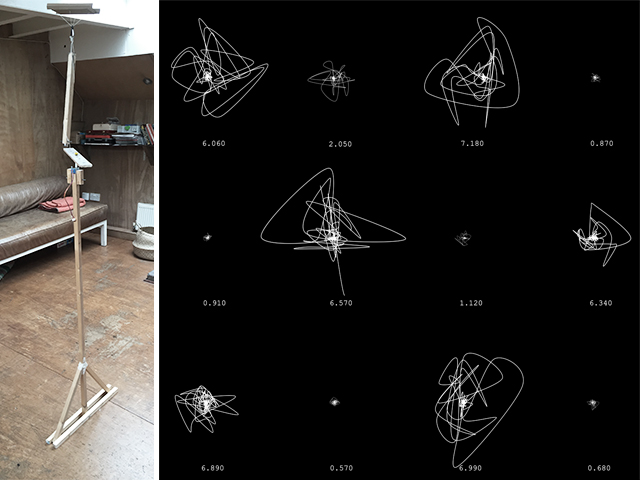The Tide's Pendulum
To become aware of an ecosystem, an animal, a plant, an insect we need to start understanding and perceiving their paths differently.
produced by: Gerolamo Gnecchi Ruscone
Introduction
Tidal shifts are the rise and fall of sea levels caused by the combined effects of the gravitational forces exerted by the Moon and the Sun on the rotation of the Earth. The Thames Tide experiences two high and two low Tides within a twenty-four hour period. Through a physical pendulum attached to a boat’s ceilings, I translated its movement to visualize and hear in real-time the paths that occur during Tidal shifts. The idea of using a pendulum as an instrument was for the simple purpose it serves: when released, it swings and oscillates freely, it is subject to the movements of the boat.
Concept and background research
The Tide's Pendulum is a multi-sensorial installation that relates to my research project on the Tide. A pendulum that as soon as it is released it will oscillate with the movements of the river. The irregularity of the river will constantly alter the pendulum's path. There are moments where the pendulum oscillates faster and creates larger paths, during Tidal shifts or when the current is strong on high Tide, and others where it shapes slower and smaller paths, while the Tide is low. Consequently, I added a rotating magnetic field under the tip of the pendulum to create an unexpected momentum. I was interested in visualizing what would happen by adding a second force during the oscillation.
1| The pendulum and some screenshots taken during specific moments of the day 2| Hand sketch on how I thought of the structure before the lockdown
Technical
The movements of the pendulum are translated into Openframeworks via touch OSC. It generates the line path and sounds (using ofMaxim) of the pendulum. The viewer will visualize smooth and elastic movements of the line during high or low tide, but when it is nearly reaching one of the two peaks it becomes noisier. The noisiness of the line, as well as the frequency and amplitude of the sound, alternates during tidal shifts.
The pendulum is attached to a boat's ceiling. Underneath it, there is a wooden structure holding a surface of rotating magnets (using a stepper motor), that will interact with the tip of the pendulum. The same magnets poles are facing each other so they will push each other away creating a perpetual motion.
One of the challenges I overcame was mainly to smoothen the line since the connection via my touch OSC, for some reason created scattered and noisy lines. Another challenge was to redefine the design of the initial sketch. The encounter of recycled materials around the area I live in helped to build a 1:1 scale installation.
Future development
I see this project as a prototype, a first step in developing a multi-sensorial floating pavilion as proposed in my research project. link to research paper: https://issuu.com/gerolamognecchi/docs/the_tide. A swarm of pendulums, a transformative structure that floats and reacts to the shifts of the river. Furthermore I would like to experiment and understand how I could translate multiple movements (testing other methods such as computer vision? machine learning?) and generate visuals and sounds.
Self evaluation
I am overall satisfied with the project, at least being able to combine a technique, Openframeworks, to personal research and ideas. When learning new skills it is an important step to start elaborating your own artistic language. Regarding the code, I decided to keep it simple. Yet for future development, I would like to explore further variations of the lines, maybe using a particle system, or apply machine learning, and so on. Adding API data of the Tide could have also enriched the code since at the moment the shift of the line is caused by a preset timer that I used. Another aspect I will improve is the sound. I honestly had difficulties generating what I wanted with ofMaxim. In the end, I kept a basic manipulation of frequencies and amplitudes, which I thought suited best the movements of the pendulum. For the future, I will combine Max Msp to Openframeworks.
References
https://openframeworks.cc/ofBook/chapters/lines.html
Creative Coding tutorials on ofxMaxim & ofxOsc
https://www.tate.org.uk/art/artists/takis-2019/introducing-takis
































































